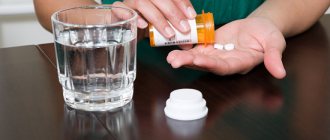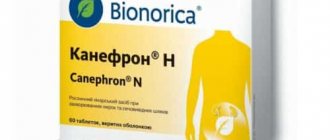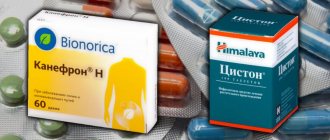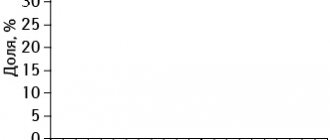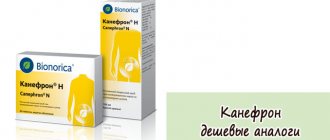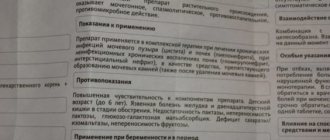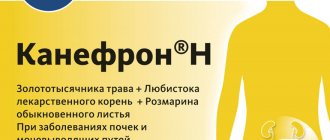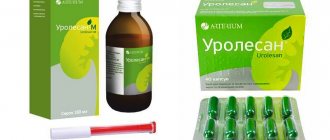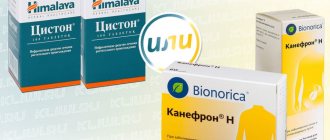Severe symptoms help doctors make a diagnosis immediately after talking with the patient. The most common clinical manifestations are:
- Painful urination.
- Frequent and strong urges.
- Sharp pain when going to the toilet.
- Feeling of incomplete emptying of the bladder.
- Discomfort.
- Pain in the lower abdomen.
Cystitis in acute and chronic forms is treated with antibiotics (amoxicillin, fosfomycin), antimicrobial drugs - nitrofuran derivatives (furazidin), as well as drugs based on herbal components. We will dwell in detail on the two most commonly prescribed medications - Furagin (furazidine) and Canephron (combined herbal medicine) and compare them.
Canephron: general information about the drug, pharmacological properties
Canephron contains herbal active ingredients, such as rose hips, lovage, centaury, rosemary, as well as excipients that vary depending on the dosage form of the drug.
Rosehip contains antioxidants (ascorbic acid, carotene), organic acids and pectins, lovage contains phenolcarboxylic acids and phthalides, centaury is rich in phenolic acids and flavonoids, and rosemary is rich in essential oils.
This diversity allows this product to have a complex effect: relieve inflammation and spasm, have a diuretic and antibacterial effect.
Canephron is indicated for the treatment of acute and chronic diseases of the kidneys (pyelonephritis, glomerulonephritis, interstitial nephritis) and bladder (for example, cystitis), as well as as a means of preventing urolithiasis.
Watch the video instructions for using the drug:
The mechanism of action of Canephron is determined by the specificity of the active components. Rosmarinic acid relieves inflammation, flavonoids relax muscle tissue, relieving spasms, essential oils remove excess fluid from the body without disturbing the water-salt balance, antioxidants remove toxins and have an antibacterial effect.
In addition to the complex effect on the kidneys and bladder, it should be noted that the drug has virtually no side effects and is generally well tolerated by patients.
The only exceptions are cases of individual intolerance and hypersensitivity to the components of Canephron.
In addition, the product does not have a negative impact on the ability to drive a vehicle or engage in activities that require high concentration; does not give negative effects when interacting with other drugs and does not cause intoxication when taking an excessive dose.
However, you should know that this remedy is not intended to eliminate edema in heart and kidney failure, is not recommended in the presence of peptic ulcers, especially during relapse, and is not the main medicine for impaired renal function.
Canephron is not prescribed for children under 6 years of age.
Pregnant and lactating women can take the drug only as prescribed by a doctor.
Canephron is available in the form of tablets (dragées) and drops .
The average price is 280-400 rubles for drops and 325-400 rubles for tablets.
Instructions for use, standard doses for adults and children
Canephron should be prescribed by your doctor. The duration of therapy courses is selected for each patient individually and depends on the characteristics of the urological disease.
Urologists recommend continuing therapy with the herbal complex for two to three weeks after the main symptoms of the disease disappear.
The liquid form of the herbal drug Canephron can be used at any age, but most often it is prescribed to infants and children under 5 years of age.
Standard dosages:
- For children under 12 months, the solution is prescribed three times a day, 10 drops;
- From 12 months to 5 years, a single dose is 15 drops, the product is taken three times a day;
- After 5 years, the amount of the dose increases to 25 drops. The frequency of its administration is three times a day;
- For adult patients, Canephron solution can be prescribed three times a day, 50 drops.
It is recommended to dilute the drops with a small amount of water before taking. To neutralize the specific taste, small children are allowed to mix the liquid with juice, fruit drink, and compote.
Canephron in the form of tablets is prescribed after 5 years. Children are given one tablet three times a day, adults two tablets three times a day. The dragee does not need to be chewed; it is drunk whole.
The manufacturer claims that the effectiveness of the drug is not affected by food. Therefore, it is taken at any convenient time, but the intervals between taking the medication should be the same if possible. While taking Canephron, you should drink as much water as possible.
Canephron is a safe drug and is prescribed to children for the treatment of diseases of the urinary system. You can start taking this medicine from 1 month of age.
The most convenient form of release for children under 6 years of age is drops. Infants take 10 drops 3 times a day, from 1 year to 6 years - 15 drops 3 times a day.
Children who have reached 6 years of age can take both drops and tablets. The dosage in this case is 25 drops or 1 tablet 3 times a day.
It is advisable to coordinate the intake of the drug with a doctor who, depending on the child’s health condition, will prescribe the most effective dosage and duration of treatment.
How can I replace Canephron?
Among the drugs that have properties similar to Canephron, the most popular are Cyston, Furagin and Fitolysin.
Cyston: general information about the drug, pharmacological properties
Like Canephron, Cyston has diuretic, anti-inflammatory, antispasmodic and antibacterial effects.
This drug contains herbal components that have a positive effect on the kidneys and bladder.
Among them are such active components as saxifrage stem, didymocarpus flowers, membranous syringe, heart-leaved madder, rough strawflower seeds, ashy vernonia, multileaf onosma.
Important!
To treat kidney diseases, our readers successfully use Galina Savina’s method .
In addition, Cyston contains purified mineral resin, silicon lime, as well as auxiliary components.
Thanks to its active components, Cyston is prescribed for urolithiasis, urinary tract infections, attacks of renal colic, cystitis, pyelitis, and urinary disorders.
The mechanism of action of Cyston is determined by the specificity of the active components. Almost all the plants included in the drug have a diuretic effect and neutralize inflammatory processes; saxifrage, didymocarpus, sith and onosma have antibacterial and antimicrobial properties; strawflower and vernonia relieve spasms.
It is important that the drug has virtually no side effects and is generally well tolerated by patients, except in cases of individual intolerance to the components of Cyston, which is the only contraindication for the use of the drug.
Cystone does not have negative effects when interacting with other drugs and does not cause intoxication if the dosage is exceeded; it can be used during pregnancy and lactation.
It is not recommended to use this drug only in cases of impaired conductivity of the urinary tract due to stones with a diameter of more than 10 mm.
Cystone is available in tablet form.
The average price is 200-330 rubles, so this analogue of Canephron is cheaper.
Furagin: general information about the drug, pharmacological properties
Unlike Canephron and Cyston, Furagin is a drug of synthetic origin that has an antimicrobial effect.
Furagin contains one active component – furazidin. The mechanism of its action is that furazidin disrupts metabolic processes in microbial cells, thereby neutralizing harmful microorganisms. In addition, the entry of the active substance into the lymph prevents the spread of bacteria through the lymphatic system.
Furagin is prescribed for the treatment of cystitis, pyelonephritis (acute and chronic), urethritis, in the presence of infectious complications arising after surgery of the urinary system, and also as a means of preventing infectious diseases of the urinary tract.
It should be noted that the use of Furagin may cause side effects such as dizziness, drowsiness, gastrointestinal disorders, allergic reactions and general malaise. The use of the drug is contraindicated in the presence of renal failure, polyneuropathy, as well as during pregnancy and lactation.
The use of Furagin can have a negative effect when combined with other drugs and in case of inaccurate dosage.
Dispensed only with a doctor's prescription.
Furagin is available in tablet form.
The average price is 50-150 rubles, making it a cheap analogue of Canephron.
Phytolysin: general information about the drug, pharmacological properties
Phytolysin is a drug that has a diuretic, analgesic, and anti-inflammatory effect. In addition, the drug prevents the spread of bacteria and facilitates the removal of urinary stones (calculi).
Our readers recommend!
For the prevention of diseases and treatment of the kidneys and urinary system, our readers advise
Monastery tea of Father George
. It consists of 16 of the most beneficial medicinal herbs, which are extremely effective in cleansing the kidneys, in the treatment of kidney diseases, urinary tract diseases, and in cleansing the body as a whole.
Doctors' opinion..."
Phytolysin is a herbal preparation. It contains wheatgrass root, onion peel, goldenrod herb, parsley and lovage, which have an antimicrobial and disinfectant effect; birch leaves and horsetail grass, which have diuretic properties; parsley fruits, which increase the tone of the bladder walls; hernia herb and essential oils that neutralize inflammatory processes.
The drug Fitolysin is indicated for patients suffering from inflammation (infectious and non-infectious) of the kidneys and organs of the urinary system, and urolithiasis.
The use of this drug is contraindicated if the patient has acute nephritis, nephrosis, glomerulonephritis, renal or heart failure, gastritis, peptic ulcer of the gastrointestinal tract, or an allergy to the components of Phytolysin.
The drug rarely has side effects. But allergic reactions to the skin (itching, redness), headache, nausea, and changes in taste are possible.
Phytolysin is an excellent analogue of Canephron, which can be used during pregnancy and lactation.
It interacts with some medications, so you should consult your doctor before use.
Phytolysin is available in paste form. The product has a specific taste and for this reason is not always well tolerated by patients.
The average price is 260-320 rubles.
What is "Furagin"?
"Furagin" is an antimicrobial agent, a derivative of nitrofuran . It fights urinary tract infections and is also used in the postoperative period to treat infectious complications.
You should not take the drug if your kidney or liver function is impaired. Contraindications include lactation, pregnancy, and hypersensitivity. Also, the drug should not be given to children under 1 year of age. The course of treatment is usually seven to eight days. If necessary, it is repeated after 10-15 days. The drug is also used in preventive measures in a reduced dosage. Doctors advise taking Furagin with protein foods.
Which drug should I choose? Advantages and disadvantages
Canephron or Cyston: which is better?
Advantages of Canephron over Cyston:
- Less likely to cause an allergic reaction due to the lower content of plant components;
- Suitable for most patients, since cases of individual intolerance to the components of the drug are rarer due to the simplified composition;
- Reduces the amount of protein excreted from the body in the urine;
- More effective for removing stones formed by the deposition of urinary salts;
- Available in the form of tablets and drops, which allows you to choose the most convenient form of application.
Advantages of Cyston over Canephron:
- Affordable price;
- The antibacterial effect is stronger due to a more diverse composition;
- More effective in preventing the formation of kidney stones;
- Better promotes the removal of stones formed by deposits of inorganic calcium compounds;
- Safer for pregnant and lactating women;
- Fewer contraindications and side effects.
Canephron and Furagin: which drug to choose
Advantages of Canephron over Furagin:
- The active components of the drug are of plant origin;
- Suitable for use during pregnancy and lactation;
- Minimal number of side effects and contraindications;
- Does not give a negative effect when interacting with other drugs;
- Available without a prescription.
Advantages of Furagin over Canephron:
- Affordable price;
- Soft but fast action, positive effect after the first use;
- Stronger antibacterial effect;
- Despite the large list of side effects, judging by the reviews, negative manifestations are extremely rare.
Canephron or Phytolysin: which is better?
Advantages of Canephron over Phytolysin:
- More effective for removing kidney stones;
- Fewer contraindications;
- Does not give a negative effect when interacting with other drugs;
- Less likely to cause an allergic reaction due to lower content of plant components.
- Neutral taste.
Advantages of Phytolysin over Canephron:
- Affordable price;
- It is better tolerated by pregnant women, since the composition does not contain rosemary, to which expectant mothers are often hypersensitive;
- The antibacterial effect is stronger due to a more diverse composition.
An excellent solution is to use Phytolysin for cystitis - this is a very effective herbal medicine that will quickly cope with the disease.
Among the many drugs for the treatment of kidney diseases, Cyston holds a special place. You will find detailed information about the drug here.
In general, we can say that all drugs are quite effective. Therefore, before choosing, you should contact a specialist so that he can select the most suitable product for a particular case.
We also recommend reading:
source: 1pochki.ru
Canephron is the most popular and effective drug that has a diuretic effect . The components of canephron have an effect on foci of inflammation and reduce spasms of the urinary tract. The drug is now often prescribed by physicians, urologists and nephrologists for the treatment of chronic diseases. It has been produced in Germany since 1934, and, as an imported drug, is quite expensive in price. In Russia and other countries, its analogues are produced, cheap in cost, but not inferior in their medicinal characteristics.
Canephron contains only herbal ingredients, so it has almost no contraindications or negative side effects. The drug is often used in complex therapy for many diseases : chronic cystitis (caused by bladder infections), inflammatory processes of the kidneys and after removal of bladder stones to prevent the formation of new stones. It is also used in conjunction with antibacterial medications to improve the therapeutic effect.
Furadonin
To treat inflammatory processes and bladder infections, the drug Furadonin is often used, which is effective against E. coli staphylococci, pathogenic bacteria Klebsiella spp or Proteus mirabilis. It is these pathogens that most often lead to the development of cystitis. Accordingly, Furadonin is a potent antimicrobial drug of synthetic origin.
Indications and contraindications
Since Furadonin is an antimicrobial drug, accordingly, the indications for its use should be diseases provoked by a pathogenic agent. Namely:
In addition, a drug from the nitrofuran group is prescribed for the prevention of infections during urological examinations (catheterization, for example) and after operations.
- individual intolerance to the components in the composition;
- liver diseases of acute and chronic form;
- chronic heart failure;
- children up to 1 month;
- acute porphyria;
- deficiency of glucose-6-phosphate dehydrogenase;
- period of gestation and breastfeeding.
Canephron: cheap Russian-made analogues
Russian analogs of Canephron have a lower price, but have a positive effect in the treatment of diseases associated with inflammatory processes in the genitourinary system and kidneys.
Furagin
Furagin contains an active substance of synthetic origin - furazidin. Its action is based on the destruction of metabolic processes in the cells of harmful microbes that cause inflammation in human organs. Furazidin also penetrates the lymph, which creates an obstacle to the penetration of bacteria in the lymphatic system.
Furagin is prescribed for the following diseases: cystitis (inflammation of the bladder), acute and chronic pyelonephritis (inflammatory process in the kidneys), urethritis (inflammation of the urethra), infectious postoperative complications of the genitourinary organs. It is often used to prevent diseases of the genitourinary system of infectious origin.
IT IS IMPORTANT TO KNOW!
A remedy for iron potency that acts immediately...
Furagin can cause negative side effects:
- drowsiness and dizziness;
- gastrointestinal problems;
- allergy;
- symptoms of general malaise.
Important! Furagin often provokes a negative effect when taken simultaneously with other medications or when the dosage is exceeded.
The list of contraindications includes: polyneuropathy, renal failure, should not be taken by pregnant and lactating women. Furagin is the cheapest analogue of the drug Canephron, its price is 50-150 rubles.
Phytolysin
This medicine contains the following herbal ingredients:
- wheatgrass root, goldenrod, parsley and lovage, onion peels - have an effect on harmful microbes;
- horsetail, birch leaves - have a diuretic effect;
- parsley root - helps to increase the tone of the bladder walls;
- hernia and various essential oils - neutralize inflammation in organs.
This drug is prescribed to patients suffering from inflammatory diseases of the genitourinary system, urolithiasis, and various kidney diseases.
The following diseases are contraindicated for the drug : acute nephritis, gastritis, renal failure, glomerulonephritis, gastrointestinal ulcers, heart failure, allergic reactions to plant components.
Women who are pregnant or lactating are allowed to take Phytolysin.
The release form of Phytolysin is pasty with a specific taste, which is not very convenient for patients. Price - 260-320 rubles.
Treatment of acute uncomplicated cystitis
Furadonin or Nolitsin, which is better for acute cystitis? The drugs of choice in a doctor’s practice are fluoroquinolones (norfloxacin). Nitrofurans (nitrofurantoin, furazidin) and sulfonamides (co-trimoxazole) are classified as alternative. Therefore, Nolicin is more effective for acute cystitis. It creates high concentrations in the wall of the bladder, urine, and in the tissues of the female genital organs.
For uncomplicated acute cystitis, a 3-day course of taking Nolitsin is sufficient. Longer therapy has no benefit. According to the instructions, the dosage regimen is 1 tablet. 2 times a day. A prerequisite for treatment is compliance with a drinking regime of up to 2.5 liters of water per day.
In terms of safety, Nolitsin is considered the best in the group of fluoroquinolones. During treatment, exposure to the sun should be avoided, as burns, erythema, and dermatitis are possible due to increased photosensitivity of the skin.
High microbiological activity was registered against Escherichia coli in Nolitsin and Furadonin. However, nitrofurantoin has limited use due to serious adverse reactions, primarily in the lungs.
Sulfonamide group
Previously, treatment regimens for urinary tract infections (UTIs) included Biseptol. Co-trimoxazole (Biseptol) belongs to a group of antibiotics to which there is a high level of resistance of various microorganisms. Therefore, this drug is not currently considered as a drug of choice for the treatment of cystitis and other UTIs.
Often at the pharmacy, customers are interested in whether they can take Furadonin and Biseptol together to enhance antimicrobial activity?
Nitrofurans (Furadonin, Furagin) cause adverse reactions quite often. From mild to fatal, treatment regimens for UTIs are currently being reviewed. Furadonin most often causes intestinal disorders, liver damage, allergic manifestations, and hemolytic disorders. Shortness of breath, cough with sputum, bronchospasm can be fatal.
Co-trimoxazole is called a kind of “leader” in the variety and number of adverse reactions, often life-threatening (anaphylactic shock, thrombocytopenia, hemolytic anemia) and skin reactions. It is used to a very limited extent in outpatient practice in a number of countries. Biseptol is also not recommended for pregnant women in the first trimester.
Therefore, when nitrofurans and sulfonamides are used together, the likelihood of severe adverse drug reactions increases many times over.
Nitroxoline. The drug 5-Nok, along with Furagin and Furamag, is used as anti-recurrent therapy for UTIs in school-age children. 5-Nok or Furadonin, which is better in adults in terms of effectiveness for the treatment of cystitis? It is safe to say that Nitroxoline is inferior to Norfloxacin and nitrofurans.
Foreign analogues
Cyston is an Indian-made drug that contains 14 plant components in the form of dry extracts and acts comprehensively.
Let's list some of the components:
- rough strawflower (seeds) - antispasmodic and good diuretic effects;
- stem didymocarpus and the essential oil in its composition give a diuretic effect;
- Saxifraga reed - helps in removing, dissolving stones from the kidneys and bladder, reduces irritation of the mucous membrane;
- madder cordifolia - with the help of ruberythyric acid and glycosides, it promotes the dissolution of oxalate stones, has a diuretic and astringent effect;
- membranous rash - has a disinfecting effect;
- Vernonia ashy - relieves spasms in the bladder, facilitates urination;
- mineral resin - helps improve digestion, has a positive effect on urination and metabolic processes in the body;
- silicon lime - has a diuretic effect and dissolves stones.
The drug is most often used in complex treatment (in parallel with antibiotics) of urolithiasis and infectious inflammatory diseases in the genitourinary system:
- during postoperative treatment to prevent stone disease;
- for therapy for the removal of phosphate and litholyxalate stones;
- for complex treatment of urethritis, pyelonephritis, to relieve inflammation of the bladder and kidneys caused by infection, with cystitis;
- in female patients with urinary incontinence;
- in situations of urinary disorders and detection of sand in the urine;
- for gout.
Contraindications for this drug are:
- high sensitivity to the herbal components of the drug;
- acute stage of the inflammatory process in the kidneys and urinary tract;
- children under 18 years of age;
- not recommended for large stones (more than 10 mm) due to possible blockage of the urinary tract;
- pregnancy and breastfeeding.
Comparison of the effectiveness of Furagin and Cyston
Furagin is more effective than Cyston - this means that the ability of the medicinal substance to provide the maximum possible effect is different.
For example, if the therapeutic effect of Furagin is more pronounced, then with Cyston it is impossible to achieve this effect even in large doses.
Also, the speed of therapy is an indicator of the speed of therapeutic action in Furagin and Cyston, as well as bioavailability - the amount of a drug substance reaching the place of its action in the body. The higher the bioavailability, the less it will be lost during absorption and use by the body.
What is the main difference
Canephron or Cyston
Let's look at the differences between the closest analogues Canephron and Cyston in more detail.
Canephron is better to use compared to Cyston because:
- the likelihood of allergic manifestations is less, because fewer components;
- helps reduce protein in urine;
- effective in removing stones that have formed in the bladder due to salt deposition;
- has 2 release forms (dragés and drops), which is convenient for patients.
Advantages of Cyston:
- cheaper drug;
- strong antibacterial effect due to many components;
- helps with the removal of stones;
- is more harmless for pregnant women and during lactation;
- fewer contraindications and side effects.
Canephron or Furagin
Advantages of Canephron:
- composed of plant components;
- allowed to be used during pregnancy and breastfeeding;
- has few contraindications and side effects;
- positive acts in combination with other drugs;
- You can buy it without a prescription.
Advantages of Furagin:
- cheaper;
- quickly and effectively relieves inflammation;
- has a stronger effect against bacteria;
- although it has a large list of side effects, based on their medical practice, they are very rare.
Canephron and Phytolysin
Advantages of Canephron:
- effectively used in removing kidney stones;
- has few contraindications;
- combines well in complex therapy with other drugs;
- the likelihood of an allergy is minimal, because the number of plant components is lower;
- tastes good.
Benefits of Phytolysin:
- the price is affordable for all patients;
- higher antibacterial effect due to a larger number of components;
- Due to the absence of rosemary in its composition, which is contraindicated for pregnant women, this drug is well tolerated by expectant mothers.
For reference! Many patients, when choosing the drug Canephron in a pharmacy, pay attention to the second name “Canephron N” and wonder: are these different drugs or not? So, this is the same drug, which is produced by Bionorica (Germany).
Side effects
Both pills and the liquid form of the drug Canephron are not prescribed if the patient has intolerance to any of the components included in their composition. The drops are not used by patients who have undergone a course of recovery from alcoholism, this is due to the ethanol content in them.
Canephron in the form of tablets is not used to eliminate urological pathologies in children under five years of age.
Both drops and solid forms are contraindicated for use:
- Patients with exacerbation of a chronic form of peptic ulcer;
- To reduce swelling caused by heart failure.
It is not recommended to take the drug if drinking large amounts of fluid is contraindicated; in case of severe renal failure, it should be used simultaneously with other medications.
The prescribed therapy does not cause significant adverse reactions in more than half of people. If there is hypersensitivity to the main or auxiliary components of the medication, then an allergic reaction may manifest itself in the form of:
- Hyperemia in certain areas of the body;
- Urticaria;
- Body rash and itching.
Long-term therapy with Canephron in rare cases causes loose stools, vomiting and nausea. If undesirable reactions occur, you should immediately stop taking the drug and consult a doctor to adjust the course of therapy.
Usually the drug is well tolerated, but in rare cases, individual intolerance to individual components of Canephron may occur. In this case, you should stop taking the medicine and seek medical advice.
Canephron in pill form is contraindicated for children under 5 years of age; they can be prescribed drops.
People suffering from alcoholism should not take Canephron drops, even if the disease is in remission. The presence of alcohol in the drug can provoke an exacerbation of the disease. Canephron drops should also not be prescribed to people with liver damage, since alcohol can aggravate the patient’s condition.
Phytonephrol is not recommended for use in some cases:
- the patient is allergic to certain components of the medication;
- Take special care when taking medication if you have cardiovascular diseases or serious kidney pathologies;
- It is not recommended to take Fitonephrol for pregnant women or those who are breastfeeding;
- the medicinal product is prohibited for use by children under twelve years of age;
- urolithiasis should be treated with Fitonephrol only under the supervision of a doctor. In some cases, the strong diuretic effect can harm the patient.
Phytonephrol is in most cases well tolerated by patients. In case of individual intolerance or overdose, side effects may occur: an allergic reaction, which manifests itself as rashes on the body, allergic rhinitis. Due to the diuretic effect, the water-salt balance may be disturbed, manifested by hypokalemia.
If you notice any unpleasant symptoms, stop taking the product immediately and visit a doctor. Avoid self-medication and consult your doctor about using analogues.
With all the variety of medications, the choice is best left to the doctor
All of these drugs have similar effectiveness. Therefore, when choosing the right medicine, it is better to give preference to drugs with less harmful side effects on the body. Each patient, with the help of a doctor, must select a drug based on his financial capabilities and the condition of his body.
source: SilaMan.ru
Canephron is a medicinal drug, with its help you can relieve inflammation, spasm, it has an antibacterial and diuretic effect. The drug consists of herbal components - centaury, rose hips, lovage, rosemary.
How much does Canephron cost (price)
Canephron is a fairly common and affordable drug. Finding it in city pharmacies is not difficult.
The medicine has two forms of release:
- The average price for Canephron drops is about 300 rubles per 100 ml bottle.
- The average price for Canephron (dragées) is approximately 330 rubles for packs of 60 dragees.
If we compare these forms of release with each other, we can conclude that in terms of efficiency and cost (approximately) they are equivalent.
Useful composition of Canephron and its analogues
1. Rosehip is the best antioxidant; it contains large amounts of carotene, ascorbic acid, and pectin.
2. Lovage has an antibacterial effect.
3. Centaury has a diuretic effect.
4. Rosemary contains essential oils that relieve inflammation. It contains flavonoids, which can help relax muscles.
With the help of canephron, chronic kidney disease can be cured - glomerulonephritis, pyelonephritis. It also relieves inflammation of the bladder; this is one of the best medicines for cystitis. The drug has no side effects, patients tolerate it well. It should not be used only by those who individually cannot tolerate it when an allergic reaction to herbal components occurs. All analogues of Canephron do not have an effect on the brain; using the drugs you can continue to work fully. No intoxication is observed after taking the drugs.
Folk remedies for treating cystitis
Cystitis is also treated with folk remedies and home recipes. Let's look at the most effective of them.
Dill and parsley . These two garden crops are considered useful for bladder problems and cystitis, as well as kidney problems. To alleviate the disease, you will need a decoction of leaves or seeds of parsley or dill.
It is prepared simply: 2 tablespoons of fresh herbs or dry grass, or seeds, pour half a liter of boiling water and leave for one hour, covered. Drink half a glass of infusion up to 5 times a day, regardless of meals. The duration of admission is not limited.
soda is effective for cystitis.
Recipe: 1 tablespoon of soda is poured with boiling water and drunk in small sips within 15 minutes. The average serving is 250-300 grams per serving. After the first use, relief is felt, acute pain and burning go away. If you have a sore intestine or stomach, the amount of soda should be halved.
Various berry fruit drinks . Among them, cranberry and lingonberry are in first place.
Grind the berries until mushy in an amount of 2 kg, squeeze out the juice, add 2 liters of water. Drink one glass before meals for 7-10 days. Not only the berries are useful, but also the leaves. Lingonberry leaves are excellent for treating cystitis. The decoction is made as follows: 2-3 tablespoons of chopped, washed leaves are poured with 200 ml of water, and placed in a water bath for half an hour. Filter, add a liter of boiled water and take half a glass before meals for a week.
Using the same principle as lingonberry leaves, an infusion of chamomile or bearberry is prepared, which are no less effective in the treatment of genitourinary problems and cystitis.
Shilajit is an excellent remedy against cystitis for women. With it you can do enemas, douching and medicinal mixtures taken orally.
For the mixture you need 50 g of mumiyo, dissolve it in water and drink it for 5 days in a row, then take a break for 3 days and repeat again until cystitis leaves you completely.
For douching, you need to make a one or two percent solution of mumiyo and perform douching for 2 weeks, but no more than 3 times a day.
Millet is excellent for men to treat cystitis. You need to take a millet suspension. It's easy to do:
Pour boiling water over 100g of millet cereal, let it brew until it cools, then grind well to a paste. If you thickly dilute it a little with boiled water, you get jelly. You need to drink it 4 times a day for 2 weeks.
When treating cystitis, men should also consult a doctor when using certain medicinal herbs and infusions; in rare cases, they can affect male strength and potency in general.
Contraindications for Canephron and its cheap analogues
1. Do not take if you have kidney or heart diseases.
2. Do not use if you have a peptic ulcer.
3. Small children are prohibited from taking Canephron.
4. During pregnancy and lactation, the drug can be used only after the recommendations of a doctor.
Canephron can be used both in pills and drops. The drug is expensive, so many are interested in what can replace the drug so that it is effective and inexpensive.
Conditions of storage and sale in pharmacies
The drug Canephron is sold freely in pharmacies, that is, you do not need a prescription to purchase it.
Dragee should be stored in its original original packaging where there is no access to sunlight, and the temperature is maintained in the range of 15-25 degrees Celsius. Shelf life – 4 years from the date of issue.
The solution is stored at 15-25 degrees Celsius in places protected from sunlight. The shelf life of the liquid form is 2 years, after opening the bottle it should only be used for 6 months.
Phytonephrol has a reasonable price. Urological collection costs about 95 rubles per pack, with a nominal value of 50 grams. A package with 20 sachets of the product costs approximately 135 rubles. Pricing policies vary in different cities of the country, and the pharmacy chain where the purchase was made also matters.
Store the urological collection for no more than two years in the original packaging, the room should also be well ventilated. Protect the herbal collection from children and ultraviolet radiation. Store the finished broth in the refrigerator for no more than two days. The best option is to prepare a fresh decoction every day, this way you will avoid spoilage.
Cyston is an inexpensive analogue of Canephron
Cystone is an anti-inflammatory, diuretic, antibacterial agent; it can be used to relieve spasms. The drug contains a large number of herbal components that will help improve the health of the bladder and renal system. The preparation contains ash vernonia, saxifrage, didymocarpus, silicon lime, resins. Used to treat various infections in the urinary tract, cystitis, colic.
Due to the fact that the drug contains active ingredients, it is possible to relieve inflammation; this is one of the best antibacterial and antimicrobial agents. He gets rid of the spasm.
Cyston has no side effects and is well tolerated by patients. Do not use only for allergic reactions. The drug interacts normally with other drugs; if the dosage is exceeded, there will be no intoxication. Cyston should not be used when patency in the urinary tract is impaired. The drug is cheaper than Canephron.
Is Furagin a diuretic or not?
- 1 General information 1.1 Mechanism of action
"Furagin" is an inexpensive and effective remedy for bacterial diseases of the genitourinary system. Is Furagin a diuretic? People often think about this and, after taking it, note that they began to visit the toilet more often. To answer this question, you need to familiarize yourself with the mechanism of action and recommendations for taking this drug.
Have you been fighting CYSTITIS for many years without success?
Head of the Institute: “You will be amazed at how easy it is to cure cystitis by taking it every day...
Read more "
general information
“Furagin” (pharmacies have similar drugs: “Furomag”, “Furasol”, “Furazidin”) is a medicine from the group of uroseptics. According to its chemical structure, it belongs to nitrofurans. These drugs, due to their low cost and effectiveness, are in first place when prescribed to patients with infectious lesions of the urinary organs. The most widespread use of Furagin tablets is in the treatment of inflammatory diseases of the lower parts of the urinary system - cystitis and urethritis, but can also be used in the treatment of pyelonephritis. The medicine is produced in the form of capsules, tablets and powder in ampoules for intramuscular injection.
Return to contents
Mechanism of action
"Furagin" is not an antibiotic in the usual sense. Its antimicrobial activity is due to the fact that the drug disrupts the functioning of enzymes vital for the metabolism of pathogenic bacteria. Microbes cannot grow and reproduce, so they soon die. "Furagin" demonstrates good results in the fight against both gram-positive and gram-negative microorganisms, including the main causative agents of cystitis and urethritis - Escherichia coli, staphylococci and streptococci. Since the medicine is highly toxic and irritates the walls of the stomach, it must be taken with food - otherwise there will be complaints of nausea and vomiting. The drug shows the highest effectiveness when it works in an acidic environment (pH no more than 5.5), so it is advisable to enrich your diet with proteins (meat, eggs, fish, legumes). These foods acidify the urine by producing uric acid during their metabolism.
Return to contents
Are Furagin tablets a diuretic or not?
The active substance of this drug is the antibiotic furazidin, which affects the enzymes of bacteria, causing their death.
Diuretics, based on their medicinal action, have a direct effect on the kidneys. They act on specific molecular targets in the nephrons and increase the kidneys' urine production. “Furagin” and its analogues belong to a completely different medicinal group and act on the enzymatic systems of bacteria necessary for their life. It has no effect on the kidney structures responsible for urine excretion.
Do not self-medicate! If you experience frequent urges, cramps and pain when urinating, or a feeling of incomplete emptying of the bladder, consult a doctor.
"Furagin" is mistakenly mistaken for a diuretic, because during treatment the frequency and abundance of urination increases. Probably, such an unexpected effect of the drug can be explained without going into the jungle of pharmacology. The fact is that in the acute phase of the disease, Furagin should be taken 2 tablets (100 mg) 4 times a day on the first day, and then for 7-8 days, 2 tablets three times a day. To avoid side effects, take the medicine during meals with at least a glass of water. When a person drinks an extra liter of fluid per day, this affects the functioning of his excretory system. Hence the frequent urge to urinate. As a result, it is impossible to say that “Furagin” is a diuretic, but its intake indirectly affects the amount of urine excreted.
Synthetic substitute for Canephron - Furagin
With its help you can destroy pathogenic microflora. The drug contains furazidin, when it is in the lymph, the bacteria are destroyed and do not spread further.
Furagin will help cure pyelonephritis, cystitis, urethritis, as well as complications of various infectious diseases that affect the urinary tract. Please note that Furagin leads to the following side effects:
1. Dizziness.
2. Problems with the stomach and intestines.
3. Allergic reactions.
4. The person is weak and constantly wants to sleep.
Furagin should not be used in case of heart failure, renal failure, during the lactation period, or in pregnant women. If you do not follow the dosage, the drug can be harmful. Can only be used after a doctor's prescription. The drug is inexpensive.
Canephron: description of pharmaceutical product
Canephron has two dosage forms - oral solution and tablets. The preparation does not contain any potent components other than plant substances.
When is it prescribed?
Experts prescribe Canephron to people who are sick:
- urethritis;
- cystitis;
- pyelonephritis;
- nephritis;
- glomerulonephritis;
- inflammations resulting from injuries;
- pathological processes in MS;
- chronic kidney diseases;
- relapses of various MS ailments;
- swelling during pregnancy;
- from high levels of protein in urine.
Canephron is one of the most effective drugs against cystitis. It combines well with other medications. Its main advantage is its versatility: it is suitable for treating patients of all ages.
Contraindications
Due to its versatility, Canephron has a minimal list of contraindications for use.
It is prohibited for use by persons:
- under 6 years of age;
- those suffering from chronic alcoholism or undergoing treatment for this addiction (the limitation applies only to Canephron in the form of a solution);
- with individual intolerance to the constituent components of the drug;
- during pregnancy (Canephron tablets are allowed).
If a doctor has prescribed Canephron in the form of an alcohol solution, it is suitable for use only six months after opening. If the solution is contraindicated, the patient can take capsules.
Diuretic drug Phytolysin
With its help you can relieve pain and stop the inflammatory process. It prevents bacteria from spreading and can be used to remove urinary stones. Phytolysin contains plant components - onion peels, wheatgrass, lovage, goldenrod, parsley. This is one of the best disinfectant medicines. It contains birch leaves, horsetail, and has a diuretic effect.
It is recommended to take Phytolysin for those who have an inflammatory process in the kidneys or genitourinary system. Cannot be used for nephrosis, renal, heart failure, glomerulonephritis. Please note that the drug has a large number of side effects - headaches, nausea. Pregnant women and nursing mothers are allowed to take it.
Very rarely it can cause allergies in the form of itching and redness. The medicine is produced as a paste; it has an unusual taste.
Comparison of addiction between Furagin and Cyston
Like safety, addiction also involves many factors that must be considered when evaluating a drug.
So, the totality of the values of such parameters as “o syndrome” in Furagin is quite similar to the similar values in Cyston. Withdrawal syndrome is a pathological condition that occurs after the cessation of intake of addictive or dependent substances into the body. And resistance is understood as initial immunity to a drug; in this it differs from addiction, when immunity to a drug develops over a certain period of time. The presence of resistance can only be stated if an attempt has been made to increase the dose of the drug to the maximum possible. At the same time, in Furagin the meaning of the “syndrome” is quite small, however, the same as in Cyston.
What is better to choose Canephron or cheap analogues?
Canephron contains a small amount of plant components, unlike Cyston, so an allergic reaction can be prevented. Canephron is better because it can remove kidney stones.
Cystone also has its advantages: it is affordable, has an antibacterial effect, and better removes stones that appeared due to the deposit of inorganic acids.
If you choose between Canephron and Furagin, it is better to give preference to the first drug. Canephron can be used during pregnancy and lactation period. Furagin is an inexpensive drug, fast-acting, and has a strong antibacterial effect.
When choosing between Phytolysin and Canephron, pregnant women are advised to choose the first one; it does not contain rosemary, which often causes an allergic reaction. Phytolysin is especially useful for the treatment of cystitis.
So, all medicines are effective, it is necessary to give preference to those that will help cure the disease without harming the body. Everyone individually chooses a drug that suits them based on price and effect. Self-medication is not recommended; you should consult your doctor.
source: medportal.su
Canephron analogues have recently begun to be in great demand, and there is a completely logical explanation for this. Like Canephron, they are predominantly developed on the basis of natural ingredients, are well tolerated by the body and are characterized by the absence of side effects.
Since the composition of the drugs still varies, some drugs are better at helping to cure, for example, cystitis, while others are more effective, say, at removing kidney stones or fighting a kidney infection. The variety of forms (paste, drops, dragees, etc.) and price range explain why some patients prefer cystone or canephron, others prefer furagin, phytolysin and other drugs.
Are all drinks safe for cystitis?
Alcoholic drinks
You should absolutely not drink beer, vodka, or champagne if you have cystitis. You can drink no more than 30 ml of cognac per day. White semi-sweet wine, no more than 1 glass.
Allowed for cystitis
Kefir, yogurt, liquid low-fat sour cream, compote, non-acidic juice. You should give preference to the following drinks: tea, fruit drink, jelly.
Moreover, the tea can be either green or black, but not very strong. You cannot drink coffee, cocoa and chicory!
Now you know everything or almost everything about cystitis, which means you are armed against it!
Canephron analogues: distinctive features
For those who suffer from diseases of the urinary system, urologists often recommend taking Canephron. However, in some cases, other drugs are more effective - analogues of canephron, also created on the basis of plant materials, but having a slightly different range of actions.
Among the most popular analogues of Canephron are the following drugs:
- cystone
- furagin
- phytolysin
Faced with such a choice, the buyer often doubts which drug to purchase, which will better help cope with the disease - canephron or a canephron substitute.
In order to make the right choice, it is necessary to compare the key characteristics of each medicine and evaluate how suitable it is for treating the problem that the person is facing, as well as for his individual characteristics. Let's compare Canephron with its main analogues:
Canephron analogues and substitutes. Click on the picture to enlarge
Obviously, the drugs presented differ in many ways. That is why, before buying this or that drug, you need to weigh all its advantages and disadvantages, and also be sure to consult your doctor about its use.
Cyston or Canephron?
If we compare canephron and cystone, we can say that the advantages of both drugs are their natural composition, a minimum of contraindications and side effects.
The range of applications of these drugs is also very similar. However, these drugs do not work the same in all patients. For example, for some, canephron helps remove kidney stones faster, while for others, cystone will be more effective.
This is explained by the fact that stones come in different origins. Cyston promotes the removal of phosphate stones (formed by deposits of inorganic calcium compounds), and canephron - urate kidney stones (formed by deposits of uric acid salts).
This circumstance should definitely be taken into account if you are thinking about what is better to buy - cystone or canephron - specifically for removing kidney stones. With regard to the treatment of urinary system infections, the drugs act approximately the same. In this case, the fundamental criterion when choosing a medicine may be the price (the difference is about 100 rubles).
Canephron or Furagin?
If the choice is between canephron and furagin, then in this case the following picture emerges: canephron consists of natural ingredients, and furagin is a synthetic drug characterized by a large number of contraindications and the likelihood of side effects.
Pregnant women, in whom chronic diseases often worsen and infection occurs more easily due to weakened immunity, as well as nursing women, are better off choosing Canephron, since this drug is safer.
On the other hand, when it is necessary to treat purulent wounds and other skin lesions formed as a result of infections, then furagin will cope better with this. Furagin in this case will be a slightly more economical option.
Canephron or phytolysin?
When patients complain that their kidneys hurt, in many cases the cause is stones. To facilitate and speed up the process of removing kidney stones, all of the above drugs can be used, however, due to the different composition, the effectiveness of the drugs in each case is individual.
A very effective and most often recommended drug for removing stones from the kidneys is Canephron. However, some patients may be allergic to its components. Pregnant women, for example, may be more sensitive to rosemary. In this case, you should think about what to replace Canephron with.
Doctors often recommend using phytolysin in such cases, a drug that also consists of natural herbal ingredients, but does not contain rosemary. Both drugs act mildly, can be taken even by infants and are characterized by the absence of side effects, with the exception of individual intolerance to the components of the drug. A more economical option is phytolysin.
All of the canephron analogues described above are affordable and effective drugs intended for the treatment of a wide range of urinary tract diseases. When choosing any medicine, you should carefully study its characteristics, and also not neglect the advice of doctors.
Watch the video for the article
Share information with friends:
Previous from the section
- Canephron during pregnancy and breastfeeding: instructions for the uninitiated
- Canephron for children: a safe medicine from the first days of life
- Canephron for cystitis: a safe remedy for dangerous consequences
- 16 informative reviews about Canephron
- Canephron: instructions for use. Be careful…
source: mkb-net.ru
Source: gastro-help.ru
Antibiotic KRKA Nolitsin – review
In this review I will try to describe my experience, and at the same time give my personal answers to the questions:
– Nolicin tablets, use for cystitis
– which is better - nolicin, monural or canephron?
– is nolitsin allowed for children?
– nolicin, analogues
– how to reduce pain with cystitis?
Why do we very often self-medicate for cystitis? But this is such a specific pain that you want to get rid of it by any means and right now. It seems like a frivolous thing to call an ambulance, I agree.
It’s impossible to get an appointment for a day, or even several. And if you still wait for test results... Therefore, every woman who has already had cystitis more than once prefers to know what and how to treat it.
And judging by the abundance of reviews in this thread, even those who haven’t had it know. So I want to add my two cents.
What is Nolitsin?
The international name is norfloxacin and it is an antibiotic of the fluoroquinolone group.
Based on this information, it becomes clear that in order to purchase nolitsin at a pharmacy you will have to resort to some tricks. I won’t write them here, since I’m not a bureau of bad advice. But, again, judging by the abundance of reviews in the threads of antibiotics from “self-medicators”, there are no difficulties with the purchase.
It also becomes clear that nolicin, like all fluoroquinolones, is contraindicated for children and pregnant women.
Indications for use.
Each person writing a detailed review considers it necessary to cite all possible indications for use. Most likely you have already read them ten times. Therefore, I will only write that Nolitsin is mainly prescribed for diseases of the urinary tract , sometimes in gynecology. For the treatment of all other “indications” there are now a lot of more effective drugs.
What and when is better – Nolitsin, Monural or Canephron?
Once upon a time I had cystitis for the first time and each friend recommended her favorite medicine - some Canephron, some Monural, some Nolitsin, and some have not forgotten Furadonin (or its latest fashionable name Furamag). I was really in a difficult situation. Even now, without a urine test and ultrasound of the kidneys, it is difficult to determine for sure. But under torture, my urologist told me how to make a choice “by eye”:
- If this is the first time you have had an episode of cystitis, you have never had kidney disease before, there is no pain in the lower back, there is no fever, then there is a high probability that monural will help, taken once. After taking monural, you can indulge in canephron to consolidate the result. The same regimen is often prescribed during pregnancy, but in this case, be kind enough to at least go to a gynecologist.
- If cystitis recurs, if there were/are kidney diseases, there is a fever, or lower back pain, it is better to immediately start taking nolicin. Then go and get tested and adjust the treatment if necessary, or take the entire course for 10 days, 1 tablet 2 times a day.
In other words, monural is used in treatment only where the kidneys are definitely not involved. And in easier and less stubborn cases.
Here you can get by with a furamag and it will help with a certain amount of luck. I have nothing against him, I just don’t like swallowing handfuls of pills (8 a day is too much for me).
Nolitsin will be more serious.
But Canephron is not suitable for self-treatment. It can be used for after-treatment, re-treatment, prevention of relapses, prevention of exacerbations. In my case, it was enough for me to be treated with Nolitsin a couple of times and now, for prevention, I drink kidney teas twice a year in courses of two weeks.
Nolicin analogues
Above, I did not talk about nolicin analogues, as many people consider them to be. These are all drugs of different groups and effects. Analogs include other fluoroquinolone antibiotics, for example, ciprofloxacin (ciprolet). Its effect on cystitis will be similar.
There are also synonyms - each pharmaceutical company calls norfloxacin in its own way - Norilet, Norbactin, Normax, etc.
How to relieve pain from cystitis.
Here, from my modest experience, I can recommend one and a half cups with hot water between the legs (sorry for the details) - it helps relieve the spasm, which greatly alleviates the condition. If you're lucky, you might even have time to fall asleep before the water cools down. The water should be as hot as can be tolerated, naturally. And during treatment, no-shpa is prescribed - it also relieves spasms and pain.
A few links to my reviews on medications:
Safe sleeping pill. A quarter of Donormila knocks me off my feet in five minutes. Why the effervescent form? so that I don’t have time to run to the bed???
Isofra in the treatment of acute respiratory viral infections and bacterial rhinitis. Why is isofra ineffective for ARVI by definition? Isofra or Polydex – what to choose for a runny nose?
and the most popular, I don’t know the secret:
Which birth control pills to choose after 30 years. Who is NOT allowed to take hormonal contraceptives? Why Siluet? Instructions for use in your own words.
With this, let me say goodbye, but not forever. I usually come back.
Source: https://irecommend.ru/content/chem-lechit-tsistit-kak-umenshit-bol-pri-tsistite-kogda-i-chto-luchshe-nolitsin-monural-ili
In what cases are Furamag and Canephron prescribed?
Furamag is a gentle antibiotic, effective in the treatment of genitourinary diseases belonging to the nitrofuran group. The drug is effective against damage to the genitourinary organs by harmful microorganisms that cause unpleasant symptoms. Furamag copes with the disease in the shortest possible time and prevents further development of the infection.
Furamag is prescribed for the following diseases:
- pyelonephritis;
- bladder and kidney diseases;
- urological infections;
- wound infections;
- prostatitis of bacterial etiology;
- inflammatory purulent diseases of the joints;
- chronic respiratory tract diseases;
- cystitis in acute or chronic forms;
- cholecystitis;
- sepsis;
- burns accompanied by infection;
- diseases of the reproductive system;
- infectious diseases of the dermis;
- diseases of the genital organs of an infectious nature;
- urethritis.
If we compare Furamag with the drug Canephron, the latter is prescribed for non-infectious diseases of the urinary system, when it is enough to carry out anti-inflammatory therapy, at the same time due to the diuretic effect, removing harmful microorganisms. In this case, there is no need to take Furamag, but if the examination revealed staphylococcal, streptococcal bacteria, salmonella, lamblia and E. coli, then without antibiotics treatment will be useless.
Due to its wide spectrum of action, Furamag is effective in the treatment of many diseases, which is due to its high antimicrobial activity, while Canephron has only a diuretic and anti-inflammatory effect and its use will be ineffective for such diseases. However, effectiveness is noted if Furamag is taken with Canephron at the same time, the drugs help destroy harmful microorganisms, while simultaneously promoting their rapid elimination from the body.
